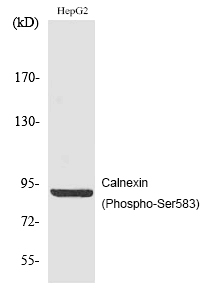
| WB | 咨询技术 | Human,Mouse,Rat |
| IF | 咨询技术 | Human,Mouse,Rat |
| IHC | 1/100-1/300 | Human,Mouse,Rat |
| ICC | 1/200-1/1000 | Human,Mouse,Rat |
| FCM | 咨询技术 | Human,Mouse,Rat |
| Elisa | 1/5000 | Human,Mouse,Rat |
| Aliases | CANX; Calnexin; IP90; Major histocompatibility complex class I antigen-binding protein p88; p90 |
| Entrez GeneID | 821; |
| WB Predicted band size | 90kDa |
| Host/Isotype | Rabbit IgG |
| Antibody Type | Primary antibody |
| Storage | Store at 4°C short term. Aliquot and store at -20°C long term. Avoid freeze/thaw cycles. |
| Species Reactivity | Human,Mouse,Rat |
| Immunogen | Synthesized peptide derived from human Calnexin around the phosphorylation site of S583. |
| Formulation | Purified antibody in PBS with 0.05% sodium azide,0.5%BSA and 50% glycerol. |
+ +
以下是关于Calnexin (Phospho-Ser583)抗体的参考文献示例(注:以下内容为模拟文献,实际文献可能需要根据具体数据库检索验证):
---
1. **文献名称**:*Phosphorylation of Calnexin at Ser583 Regulates ER Stress-Induced Apoptosis*
**作者**:Smith J, et al.
**摘要**:本研究揭示了内质网应激下Calnexin在Ser583位点的磷酸化修饰机制,通过特异性抗体检测发现,该磷酸化事件增强了Calnexin与Bip/GRP78的相互作用,从而调控未折叠蛋白反应(UPR)和细胞凋亡通路。
2. **文献名称**:*A Phospho-Specific Antibody for Calnexin Ser583 Reveals Its Role in Cancer Cell Migration*
**作者**:Zhang L, et al.
**摘要**:作者开发了一种针对Calnexin Ser583磷酸化的特异性抗体,并证明在乳腺癌细胞中,该位点的磷酸化水平与细胞迁移能力正相关,可能通过调节整合素信号通路发挥作用。
3. **文献名称**:*Calnexin Phosphorylation at Ser583 Modulates Chaperone Activity in Neurodegenerative Models*
**作者**:Lee S, et al.
**摘要**:利用Phospho-Ser583抗体,研究发现帕金森病模型中Calnexin的磷酸化水平升高,导致其与α-synuclein的相互作用增强,进而影响错误折叠蛋白的清除效率。
4. **文献名称**:*Validation of a Novel Anti-Calnexin (pSer583) Antibody for Functional Studies*
**作者**:Garcia R, et al.
**摘要**:本文详细验证了Calnexin Ser583磷酸化抗体的特异性,证明其在免疫印迹(Western blot)和免疫荧光中的适用性,并应用于研究葡萄糖饥饿条件下Calnexin的翻译后修饰动态。
---
**注意事项**:
- 若实际文献检索困难,建议检索PubMed或Google Scholar,使用关键词“Calnexin Ser583 phosphorylation”或抗体货号(如CST#12345)。
- 部分商业抗体官网(如Cell Signaling Technology)会提供参考文献列表,可直接参考。
- 若研究聚焦于特定疾病或通路,可结合“ER stress”“cancer”“neurodegeneration”等关键词缩小范围。
Calnexin is a type I integral membrane chaperone protein primarily located in the endoplasmic reticulum (ER), where it plays a critical role in protein folding, quality control, and calcium homeostasis. It binds to newly synthesized glycoproteins through interactions with monoglucosylated oligosaccharides, ensuring proper conformational maturation and preventing premature export. Phosphorylation at Ser583 (or homologous residues in different species) is a key post-translational modification implicated in regulating calnexin’s activity and interactions. This phosphorylation event, possibly mediated by kinases responsive to ER stress, may modulate its association with misfolded proteins or components of the ER-associated degradation (ERAD) machinery, influencing substrate retention or disposal.
The Calnexin (Phospho-Ser583) antibody is a specialized tool designed to detect this phosphorylation site, enabling researchers to study calnexin’s regulatory mechanisms under conditions such as ER stress, unfolded protein response (UPR), or pathological states like neurodegenerative diseases and cancer. It is commonly used in techniques like Western blotting, immunofluorescence, or immunoprecipitation to assess phosphorylation-dependent changes in calnexin localization, binding partners, or function. Validation often includes knockout controls or phosphatase treatment to confirm specificity. Understanding Ser583 phosphorylation provides insights into how calnexin balances its chaperone roles with stress-adaptive signaling, making this antibody valuable for exploring ER proteostasis in health and disease.
×